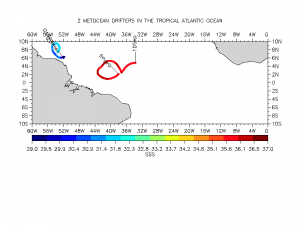Comparison of SMOS Sea Surface Salinity with SSS from in situ drifters in the tropical Atlantic Ocean evidence that SMOS senses large salinity gradients, but contamination by land remains
J. Boutin, G. Reverdin, N. Martin, S. Morrisset (LOCEAN)
In order to dispose of salinity measured as close as possible to the sea surface for validating SMOS SSS (representative of the 1cm of the sea surface), numerous surface conductivity/temperature drifters have been deployed in the frame of the french CNES/TOSCA program (GLOSCAL project). Data recorded by these drifters can be viewed on: http://www.locean-ipsl.upmc.fr/smos/drifters/.
Two drifters were deployed this summer in the tropical Atlantic showing large contrasts of SSS linked to the fresh water discharged by the Amazone river and transported northward by the north Brazil current:
SMOS SSS retrieved with the L2 OS processor were colocated at +/-25km, +/-2 days from these drifters. SMOS SSS were averaged around each drifter data, the average being weighted by the error on individual retrieved SSS and by their mean resolution.
Figures below illustrate that on descending orbits, SMOS well sees the salinity contrast between the two drifters . Close to the coast, SSS on ascending orbits are clearly out of range.
Figure 2: Comparison of SMOS SSS (retrieved with L2 OS processor, model 1, green: on descending orbits; red: on ascending orbits) with SSS recorded by drifter Metocean 66270 (around 36psu) . West of 40W, SMOS SSS are noisier, especially on ascending orbits, illustrating that a pollution by land is still present.
Figure 3: Comparison of SMOS SSS (retrieved with L2 OS processor, model 1) with SSS recorded by drifter Metocean 63220 (SSS between 29 and 32psu), that remains close to the coast. While on descending orbits (green points), SMOS SSS are consistent with the drifter measurements, SSS on ascending orbits are well above the expected values.



